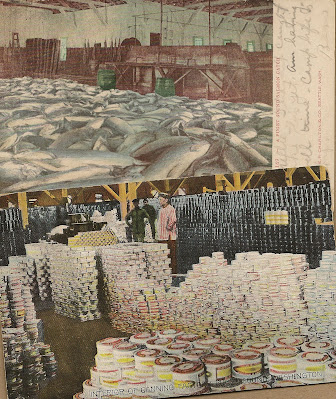Salmon Canning Got an Early Start at Semiahmoo
 |
PNW canned salmon by the case. |
The start of modern salmon canning in Northwest Washington came in 1891 when a man named Drysdale established a cannery at Semiahmoo, Blaine's "spit."
Actually, Martin & Tarte had operated a crude cannery at Semiahmoo as early as 1881, but it was unsuccessful financially and Capt. J.W. Tarte left after the first season and returned to steamboating for which he was better known.
Drysdale's cannery was more like the present ones and put up a fair pack in 1892. The next year A. E. Wadhams constructed a similar operation at Point Roberts. That was 1893, the year of the biggest salmon run then of record (to 1953.) Drysdale got 35,000 sockeye in one day and both canneries had to order additional cans. They packed more than 100,000 cases and employed 130 white men, 140 Natives, and 150 Chinese.
Point Roberts was proving a great place for traps and fishing boats and the British Columbia parliament––even then–– discussed buying Point Roberts.
Alaska Packers Buys Sites
Alaska Packers Association, still in business at Semiahmoo, bought both Point Roberts and Semiahmoo cannery sites and equipment early in 1894 and obtained complete control of Point Roberts by buying other properties and leases.
However, APA, a $5,000,000 corporation with 28 Pacific canneries, had a disappointing season, packing only 37,000 cases in 1894, while contracting with Chinese labor for packing 70,000.
Although the Bellingham Bay Fish Company was organized in 1893 to dry, smoke, pack, and ship fresh fish of all kinds, it was not until 1895 that a cannery was established at Fort Bellingham. It was an old enterprise but showed definite initiative on the part of the entrepreneurs.
With hard times on Bellingham Bay, plumbers E. N. Haskell and Archie F. Allen in 1894 canned 200 salmon in the Allen building opposite the Roth block, using an old tin boiler as a cooker. They were joined by another plumber, two painters, and a photographer––respectively Charles Brandes, C. H. Clift, Frank Bennett, and A. D. Bonney––in the Village Point Canning Company. Unfortunately, the painters couldn't catch enough fish to keep the plumbers and photographers busy more than one day a week. They put up 250 cases, sold them for $900, dismantled the cannery, sold the boiler to F. A. Buck for $25 to use in running his Ferndale cheese factory, and resumed their former occupations.
The first really commercial cannery on the Bay was the Fairhaven Canning Co, established in 1896. The next year the new cannery of Henry N. Newton and John H. Baines was operated in July as the Bellingham Bay Canning Co., subsequently to be operated by Dan Campbell's Astoria & Puget Sound.
B. A. Seaborg, president of Aberdeen Packing Co, built a large cannery on the present P.A.F. cannery site in 1897. Seaborg, a Columbia River salmon pioneer, was followed by Roland Gaffroy and Dr. Adrian Mounod, and their Franco-American North Pacific Packing Co. It failed, but the PAF succeeded it in 1899, only to be taken over by the gigantic Pacific Packing and Navigation Co and then to regain its identity in 1905.
In 1901, Whatcom's 12 canneries put up 66 percent of the total Puget Sound pack. The county's fisheries employed 4,481 white persons, from three to eight months in the year, in addition to 1,000 Chinese and Japanese cannery workers.
Whatcom county's pack was 935,000 cases, valued at $4,000,000. Forty steamboats, 24 pile drivers, 250 large salmon scows, and 250 other boats were in use.
A quarter of a century late, eight Whatcom canneries packed 446,108 full cases.
A decade later, salmon traps were outlawed [1934] and the major Bellingham companies had focused major attention on Alaska runs.
Though the present pack of Puget Sound salmon is only a fraction of the 1,415,000 cases of the great sockeye year of 1901, the resource remains one of the area's greatest.
In 1901, Whatcom's 12 canneries put up 66 percent of the total Puget Sound pack. The county's fisheries employed 4,481 white persons, from three to eight months in the year, in addition to 1,000 Chinese and Japanese cannery workers.
Whatcom county's pack was 935,000 cases, valued at $4,000,000. Forty steamboats, 24 pile drivers, 250 large salmon scows, and 250 other boats were in use.
A quarter of a century late, eight Whatcom canneries packed 446,108 full cases.
A decade later, salmon traps were outlawed [1934] and the major Bellingham companies had focused major attention on Alaska runs.
Though the present pack of Puget Sound salmon is only a fraction of the 1,415,000 cases of the great sockeye year of 1901, the resource remains one of the area's greatest.
Bellingham Herald, April 1953. From the archives of the Saltwater People Historical Society.





No comments:
Post a Comment